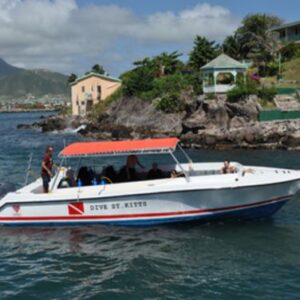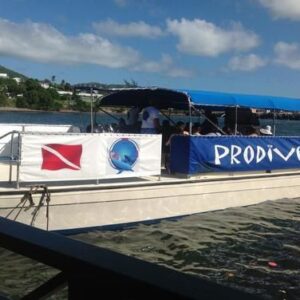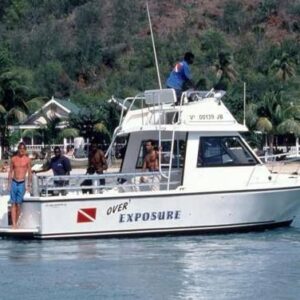Adventures in Volcanic Environment
Tranquil waters, gentle reefs and relaxing dives describe scuba diving in St Kitts and Nevis. Located in the northeast corner of the Caribbean, the western side of the islands border the Caribbean Sea while the eastern coasts face the Atlantic Ocean. Scuba divers of all ages and skills will relish the magnificent underwater world. From near-shore reefs, maze like swim-throughs, and subaquatic caves, divers will appreciate incredible visibility of walls, ledges, under hangs, coral towers and sunken wrecks all teeming with marine life.
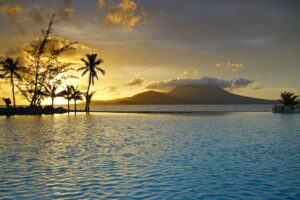
GETTING THERE
Air: Nonstop flights and charter flights depart daily arriving at Robert Llewellyn Bradshaw International Airport (SKB).
GETTING AROUND
Car Rentals: Visitors must obtain a driver’s permit before being allowed to rent a car.
Scooters/Bike Rentals: All terrain scooters and bikes can be rented and is a great option for exploring the island.
Taxi and Minibus: Taxis are abundantly available. Fares should be negotiated before departure. Minibuses are a cheaper option and can be flagged down while enroute.
Ferry/Water Taxi: Ferries between St Kitts and Nevis take about 45 minutes. Water Taxis provide trips from St Kitts to Nevis and are a charted service.
GOOD TO KNOW
Country: Independent state in association with the United Kingdom
Time Zone: UTC-4:00
Primary Language: English
Currency: East Caribbean Dollars (XCD)
Cell Phone Service: Roaming fees apply.
Voltage: 230 Volts
Passport and Visa: Passport must have 6 months validity at entry and 1 page for entry stamp.
Hurricane Details: June to November. St Kitts and Nevis lies on the southern edge of the Atlantic hurricane belt.
DIVE CONDITIONS
Water Temperature: 74-85 degrees F
Water Visibility: 60-100 feet
When to Go: Due to cooler and dryer weather, December – May are the best months to travel.
Diving Difficulty: Beginner-Advanced
TOP DIVE SITES IN SAINT KITTS AND NEVIS
St Kitts and Nevis caters to the diving enthusiast! Listed are some of the very best that these islands can offer divers:
- Coconut Tree Reef is one of the area’s largest reefs at a depth of 40 feet. With a variety of corals and a wall that plunges 100 feet, divers will appreciate a variety of marine life including barracuda, grunts, snappers, eels, turtles, and nurse sharks. Coconut Shallows is an extension of the reef that gradually drops off with lots of small fish, lobsters and nurse and Caribbean reef sharks.
- Green Point Reef is a great site for drift diving and is full of sea life. The depths vary from 25-50 feet where a variety of soft corals, sponges and sea fans can be found. Divers can expect to observe angel fish, snapper, grouper, stingrays, and hawksbill turtles.
- Monkey Shoals (AKA the Donut) is located between St Kitts and Nevis and home to a circular section of reef (the donut) with extended limestone shelves. The large, two-mile coral atoll is encrusted with hard and soft corals such as pillar coral, large brain coral and elkhorn coral. With depths from 40 feet to over 100 feet, Monkey Shoals is home to the unique flying gurnard, scorpion fish, spiny lobsters, French and gray angel fish, and nurse sharks. This site is prone to high winds and rough currents which makes it a fabulous site for drift dives. Coral Gardens sits next to Monkey Shoals and provides divers with a gentle drop off that has extensive growth of tube sponges, sea fans and anemones. Schools of Atlantic Spadefish and large schools of horse-eyed jacks are curious and love to swim around and between groups of divers.
- The Thermal Vents is a unique site that begins at a shallow 35 feet before plunging to a depth of 95 feet. The reef is covered with huge black coral trees, wire coral and sponges with overhangs and small canyons. These spots provide spotted drums, high hats, and large lobsters places to hide. The bottoms are home to underwater thermal vents that emit water at 100 degrees F.
- Nags Head is a reef that has a depth from 20 feet to 80 feet and is located where the Atlantic and Caribbean Sea meet off the southern tip of St Kitts. This rocky formation has a small wall and grassy area that is home to sea urchins, crustaceans, feather stars, parrotfish, and eagle rays. Due to the strong currents, this site is recommended for advanced divers.
- Christena Wreck is a ferry resting upright in the sand. Christena sank in the Narrows in 1970. Divers will enjoy hard and soft corals, lobsters, moray eels and schools of fish. Beginners and advanced divers can enjoy this diving site.
- Sandy Point Reef is one of the healthiest reefs in the area and ranges from 50 to 130 feet. With swim-throughs, divers can expect to see angel fish, barracudas, eels, turtles, and lobsters.
- The River Taw is the most popular island shipwreck. This 144-foot freighter sunk in 1985 and rests in two pieces in the water at 40 feet. This site is often used for scuba instruction. Divers are allowed to feed the fish here and can expect to see lobsters, octopus, turtles, snappers, stingrays, and squirrelfish.
- The Corinthian (AKA the Tug) is a reef system and tugboat wreck that sits on the sandy bottom with depths of 30-65 feet. This is an easier dive and fish feeding is allowed.
- The Talata is a wrecked freighter in 55 feet of water and suitable for beginner divers and photographers. The freighter sits in pieces due to past hurricanes and surges on a reef near Basseterre Harbor. This popular site has beautiful corals with rich marine life. Divers can observe sergeant majors, trumpetfish, moray eels, and creole wrasse.
- Brimstone Shallows is a diverse site suitable for all levels of divers located west of Port Zante Marina. This site has both a reef and a wall with depths of 50 to 100 feet. With beautiful hard and soft corals, divers will enjoy schools of Creole wrasses, lobster, barracuda, moray eels, turtles, and reef sharks.
- The Aquarium is a challenging dive site for advanced divers. This rough water site has depths of 60 to 90 feet where stingrays and nurse sharks can be found.
Nevis
- Devil’s Caverns is located off the west coast of Nevis. Divers will love this diverse site with swim-throughs, overhangs, and coral grottos. With a maximum depth of 40 feet, divers will swim with lobsters, stingrays, blue tang, glassy sweepers, and nurse sharks.
- The Ledge is a great site for underwater photography. This bank has a depth of 30 to 60 feet and is home to nurse sharks and moray eels.
- The White Hole is located at the south end of Monkey Shoals. This site has a maximum depth of 40 feet and is home to a variety of sponges, rays, lobsters, and schools of tropical fish.
- Clyde’s Reef is a 45-foot sandy reef that is home to reef fish, turtles, and moray eels.
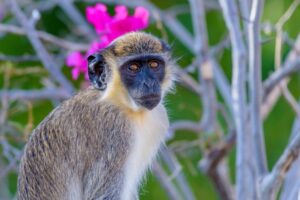
TOP ATTRACTIONS IN SAINT KITTS AND NEVIS
- Scenic Railway Tour is a scenic ride on the old sugar train. This tour provides visitors with a view of the old sugar railways, abandoned sugar plantations, churches, and the overall beauty of the island.
- Romney Manor / Caribelle-Batik is the 17th century Romney Manor Sugar Estate now known as Caribelle-Barik. This estate was once owned by Samuel Jefferson, great, great grandson of Thomas Jefferson. Today, artisans perform live demonstrations of the batik process and sell batik artwork and clothing.
- Walking Tour of Historical Basseterre includes a tour of Independence Square, the Anglican Church, the Immaculate Conception Roman Catholic Church, and the National Museum located in the Old Treasury building.
- Brimstone Hill Fortress and National Park provide visitors with an in-depth look at life as a soldier and displays 17th and 18th century architecture. This fort was built by African slave labor from nearby volcanic rock.
- Zipline the Lush Rainforests alongside a zipline staff member guiding visitors through five different lines totaling over 1000 feet. Visitors will enjoy breathtaking views of the tropical rainforests, Brimstone Hill, and green vervet monkeys.
- Hike Mt. Liamuiga is a four plus hour hike up the mountain. Hikers will pass waterfalls, the tropical rainforest, and the cloud forest. Once at the peak, visitors will be rewarded with spectacular views of the islands.
- A Day at the Beach is a wonderful way to enjoy laid-back beach bars, relax in beach chairs and admire the gorgeous Caribbean landscape. For more exhilarating adventures, an assortment of water sports is available for rent such as fly boards, and jet skis. South Friars Bay, South Frigate Bay, and Cockleshell Bay are popular beach options.
- Snorkeling at Dieppe Bay Beach has calm clear water that is ideal for tanning or relaxing on the exotic black sand. Thanks to the major reef that protects the bay, the beach is perfect for snorkeling. The waters are home to a colorful array of marine life.
- A Night on the Frigate Bay Strip is a fantastic way to taste the nightlife of Kittitian. Locals and international students gather here for the beach bars. The fresh seafood, island cocktails and energetic nightlife are a trendy way to enjoy St Kitt’s culture.
From white sandy beaches, exhilarating rainforests and dormant volcanoes, these islands are a tropical paradise. Warm turquoise waters, pristine coral reefs, historical wrecks, walls, caves, and diverse marine life make St Kitts and Nevis a diver’s paradise. These islands cater to all levels of divers and are a perfect location for beginners and those needing scuba instruction. If divers are looking to be a part of new and emerging diving sites in calm, tranquil waters, this dream scuba destination will deliver a not-soon-forgotten scuba experience.

